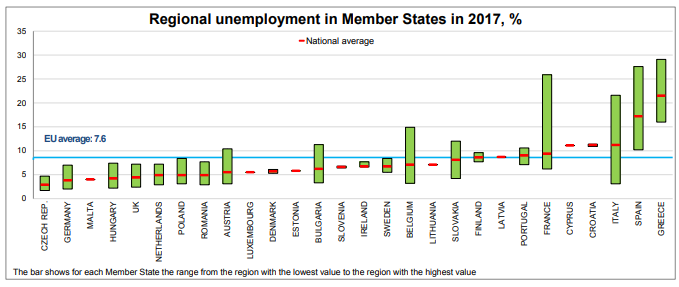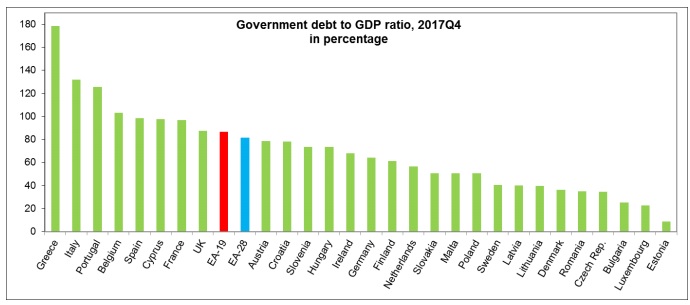Eurostat/Income inequality in the EU/26 Απριλίου 2018 Data from 2016 show wide inequalities in the distribution of income. In the EU, the top 20% of the population (with the highest income) received 5.2 times as much income as the bottom 20%. This ratio varied considerably across the Member States, from 3.5 in the Czech Republic and 3.6 in Slovenia, Slovakia and Finland, to 6.0 or more in Bulgaria (8.2), Lithuania …Read More
Unemployment rates in the EU regions ranged from 1.7% to 29.1%
Eurostat/Unemployment rates in the EU regions ranged from 1.7% to 29.1%/26 Απριλίου 2018 At the end of the fourth quarter of 2017, the government debt to GDP ratio in the euro area (EA19) stood at 86.7%, compared with 88.1% at the end of the third quarter of 2017. In the EU28, the ratio also decreased from 82.4% to 81.6%. Compared with the fourth quarter of 2016, the government debt to …Read More
The Logical Next Step for Europe’s Integration
Ferdinando Giugliano, (2018), “The Logical Next Step for Europe’s Integration”, BloomberView, 25 Απριλίου For the past year, euro-zone leaders have vowed to take steps to complete Europe’s monetary union. The 19 countries share a single currency and a central bank, but they still lack all the necessary mechanisms to deal with major imbalances and shocks. While some members would like to have more fiscal transfers and a common safety net …Read More
Labour market policies in the era of pervasive austerity A European perspective
Sotiria Theodoropoulou, (2018), “Labour market policies in the era of pervasive austerity. A European perspective”, policy press This book investigates the changing patterns of labour market and unemployment policies in EU member states during the period since fiscal austerity took hold in 2010 during the deepest postwar recession in Europe. Looking at the big European picture, do we see a convergence or a divergence in labour market and unemployment policy …Read More
Debt Overhang, Rollover Risk, and Corporate Investment: Evidence from the European Crisis
Sebnem Kalemli-Ozcan, Luc Laeven, David Moreno, (2018), “Debt Overhang, Rollover Risk, and Corporate Investment: Evidence from the European Crisis”, discussion paper, CEPR We quantify the role of financial factors that have contributed to sluggish investment in Europe in the aftermath of the 2008-2009 crisis. Using a big data approach, we match the firms to their banks based on banking relationships in 8 European countries over time, obtaining over 2 million …Read More
Deepening EMU requires a coherent and well-sequenced package
Marco Buti, Gabriele Giudice, José Leandro, (2018), “Deepening EMU requires a coherent and well-sequenced package”, 24 Απριλίου The debate on EMU deepening is entering a critical stage. The contribution of 14 French and German economists (Benassy-Quéré et al. 2018) is therefore timely. It suggests ways for reconciling risk-sharing with market discipline – where the biggest divisions lie. Their initiative overlaps in spirit and with much of the substance of the …Read More
EU banks rush to ‘have cake and eat it’ with bad loan sales
Martin Arnold (2018), “EU banks rush to ‘have cake and eat it’ with bad loan sales”, Financial Times, 23 Απριλίου Southern European banks have taken more than €14bn in extra provisions this year to write down the value of toxic loans they plan to sell, while taking advantage of a new accounting rule to delay the hit to capital. Analysts say the opportunity for banks to “have their cake and eat …Read More
Government debt fell to 86.7% of GDP in euro area
Eurostat/Government debt fell to 86.7% of GDP in euro area/24 Απριλίου 2018 At the end of the fourth quarter of 2017, the government debt to GDP ratio in the euro area (EA19) stood at 86.7%, compared with 88.1% at the end of the third quarter of 2017. In the EU28, the ratio also decreased from 82.4% to 81.6%. Compared with the fourth quarter of 2016, the government debt to GDP …Read More
The curse of persistently low real interest rates
Jan Willem van den End, Marco Hoeberichts, (2018), “The curse of persistently low real interest rates”, VoxEU, 25 Απριλίου The steady downward trend of real interest rates worldwide over the last 30 years has raised the issue of whether the natural rate – defined by Wicksell (1898) as the marginal productivity of capital – has fallen in tandem. Blanchard et al. (2014) conclude that the factors that led to low …Read More
Η Ε.Ε. θέλει να απεξαρτηθεί εμπορικά από τις ΗΠΑ
Kathimerini.gr (2018), “Η Ε.Ε. θέλει να απεξαρτηθεί εμπορικά από τις ΗΠΑ”, 24 Απριλίου Ευρωπαϊκή Ενωση και Μεξικό κατέληξαν το Σάββατο σε μια νέα συμφωνία για το ελεύθερο εμπόριο, γεγονός που αποτελεί μεγάλη επιτυχία και για τις δύο πλευρές, τη στιγμή που οι ΗΠΑ, υπό τον Ντόναλντ Τραμπ, διολισθαίνουν ολοένα και περισσότερο προς τον οικονομικό προστατευτισμό. Παράλληλα, η Ενωση επισπεύδει την επικύρωση της συμφωνίας ελευθέρου εμπορίου Ε.Ε.-Ιαπωνίας, που είχε υπογραφεί τον …Read More







